Livraison offerte dès 79€ d'achat !
Nouveautés : Les Infusions, les Ultrasons et les Upcycling !
Livraison offerte dès 79€ d'achat !
Nouveautés : Les Infusions, les Ultrasons et les Upcycling !
Native to the humid tropics of Southeast Asia, particularly the Philippines, Indonesia and Malaysia, Ylang-Ylang is a leading product in contemporary perfumery.
It was first distilled in 1860 in Manila by a sailor by the name of Albert Schwenger.
This lover of the flower and its fragrance travelled the country, still in hand, to harvest and then distill the finest specimens himself.
It was then introduced by French monks and settlers to most of the Pacific and Indian Ocean islands, notably the Comoros at the end of the 19th century.
This small archipelago quickly established itself as the world’s leading producer, thanks to the exceptional quality of its ylang-ylang.
It’s also the choice we’ve made at Le Sourceur, where we grow our ylang-ylang sustainably and responsibly.
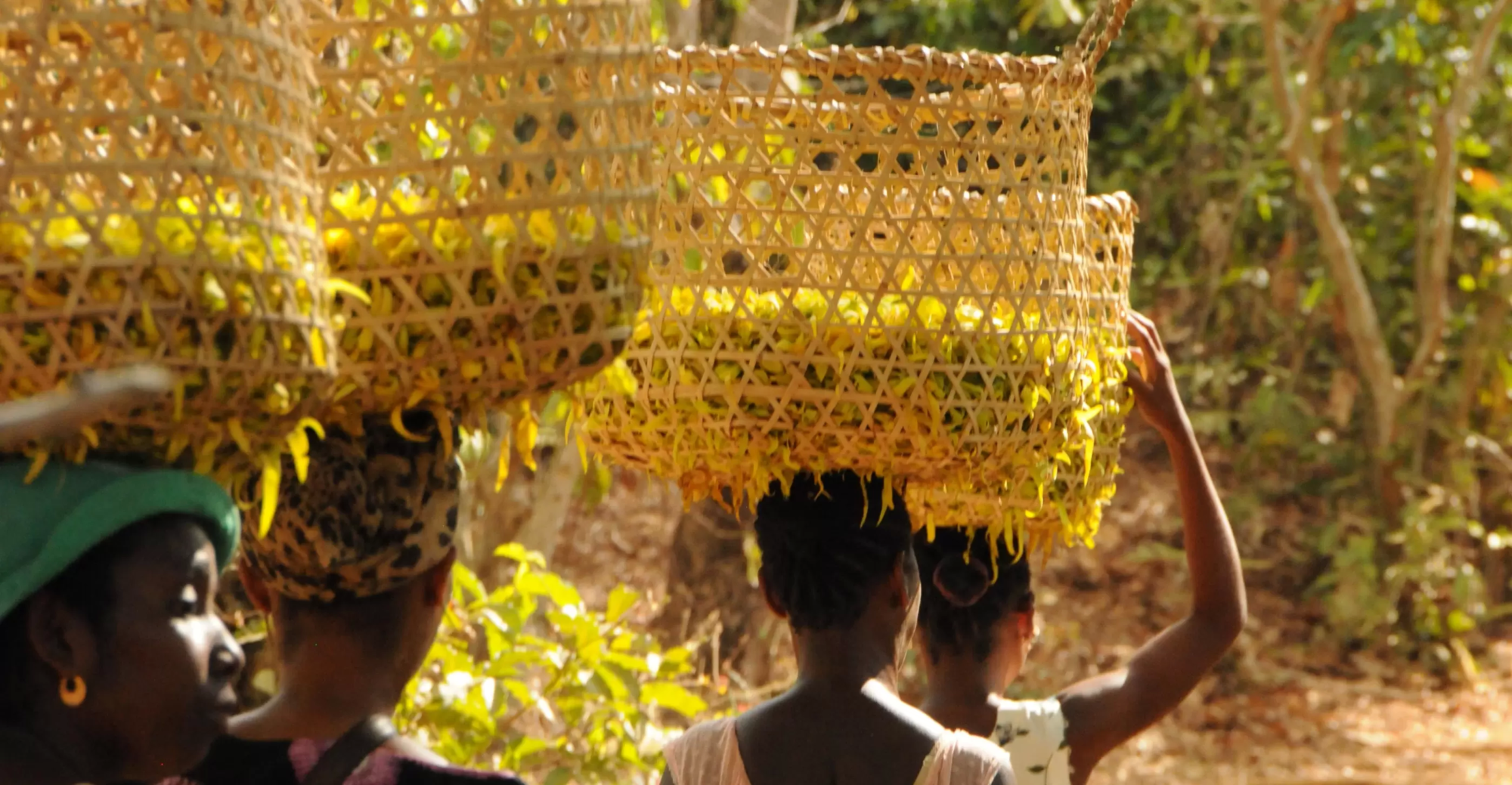
Worldwide production of Ylang essential oil is relatively low, at around 100 tonnes a year, with 70 tonnes in the Comoros alone, the vast majority of which comes from the island of Anjouan, in the south-east of the country.
Next comes Madagascar (particularly the island of Nosy Bé) with around 20 tonnes, then Mayotte with just under 10 tonnes.
In Mayotte, ylang-ylang alone accounts for 84% of total exports and is the French overseas department’s main cash crop.
Cananga odorata is a majestic evergreen tree in the Annonaceae family.
It owes its name to its particularly fragrant yellow flowers and to the Filipino “alang alang”, which literally translates as “flower of flowers”.
In a prosperous natural environment, i.e. in humid, particularly rainy and relatively sunny areas, the Ylang tree grows fast and tall, its branches pointing upwards.
In its early years, it is estimated to grow up to 5 meters per year.
For a maximum height of 30 meters and an average lifespan of half a century.
The first flowers appear in the second year, starting out white, then turning green and tending towards their beautiful yellow color.
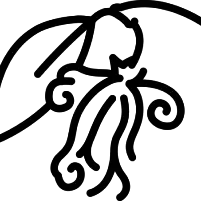
According to legend, a long time ago in the Philippines, the gods named a girl Ylang when she was born.
They added that no one should ever touch her.
But she was superb, and her striking beauty soon left no one in her village indifferent.
And soon a man for whom she was also attractive came to give her flowers, the most beautiful he could find.
But as he handed her the bouquet, their hands touched and Ylang was instantly transformed into a beautiful tree with fragrant yellow flowers.
Legend has it that ever since, her lover has sought her out, calling out her name “ylang, ylang?
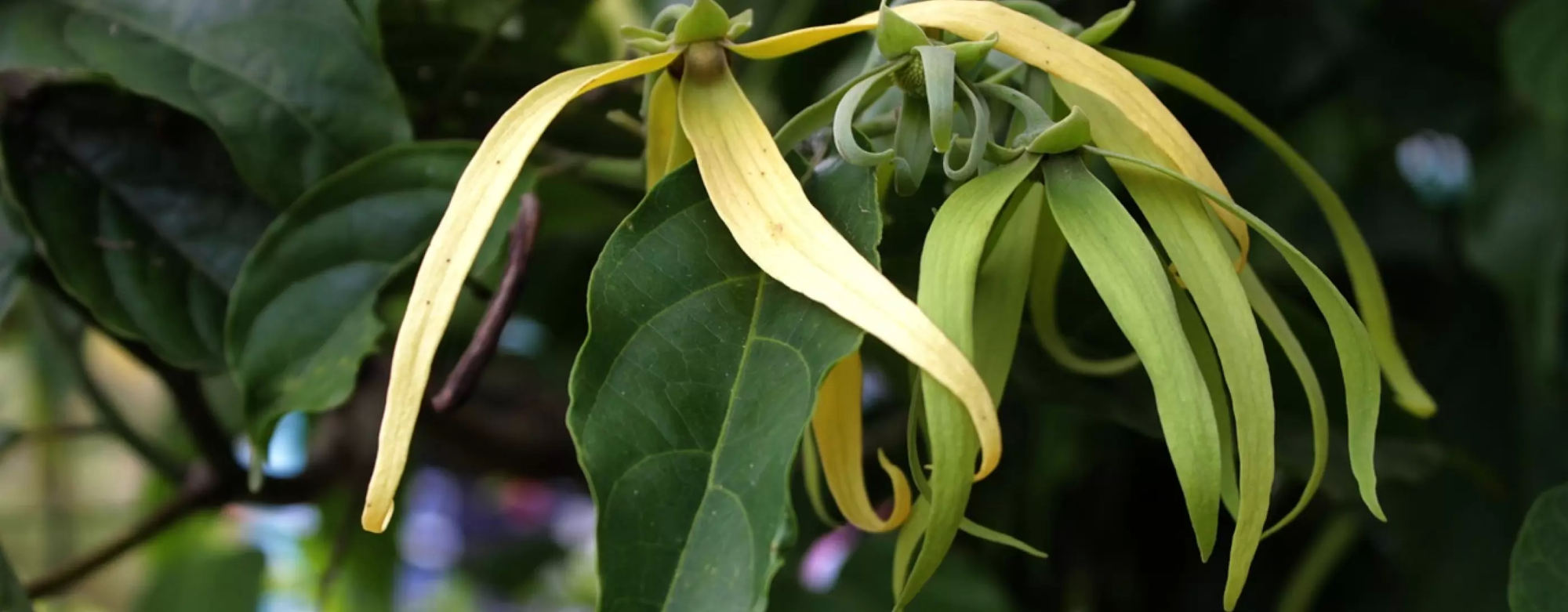
For cultivation purposes, and to make it easier to pick the flowers, we prefer to prune the Ylang tree so that it does not exceed 2-3 meters in height.
So, in its first year of growth, it is first topped, before the branches are pruned straight back.
These extremely flexible branches are then positioned vertically.
This seemingly barbaric technique stresses the tree so that it produces more flowers.
A minimum of 5kg per year from the first pruning, bearing in mind that the more flowers are harvested, the more the tree produces.
It normally takes 4 to 5 years before the ylang-tree produces an interesting quantity of flowers.
The tree produces flowers all year round and right up to the end of its life, even if production declines from the age of 30.
Harvesting ylang-ylang is essentially a woman’s job, and a fundamental step in the creation of a quality essential oil.
The flowers are generally harvested all year round, although the main harvest takes place at the end of the rainy season and lasts throughout the dry season (between May and December).
It’s essential to pick the flowers when they’re in their beautiful yellow color, otherwise they won’t have their characteristic floral fragrance.
What’s more, tradition dictates that they should be picked at dawn, the time of day when the fragrance is strongest.
Finally, the flowers come only from “mature” trees, generally from their fifth year of growth.
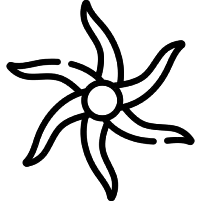
Like most essential oils, Ylang Ylang’s precious liquid is obtained by steam distillation.
It takes around 50kg of flowers to obtain 1kg of essential oil.
The flowers are plunged into a still filled with water brought to the boil using firewood (a major problem in the Comoros, but we’ll come back to this later).
This essential oil is particularly energy-intensive, and may come in 5 different qualities, commonly known as fractions: Ylang Extra Supérieur, available from Le Sourceur, Ylang Extra and completes I, II and III.
To obtain them in their entirety, no less than 20h of extraction is required, and what may seem surprising to cooking enthusiasts is that the more the flower is distilled, the less relevant its scent will be.
On the other hand, the more its properties are developed.
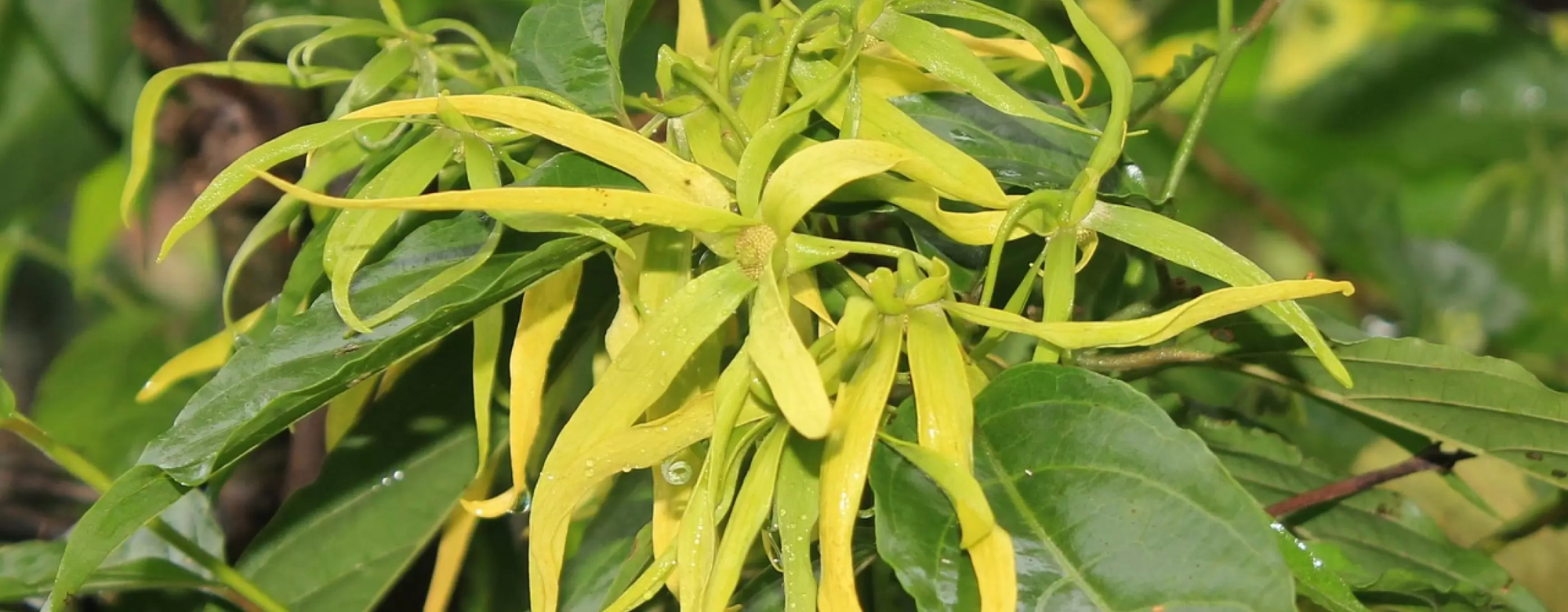
Ylang-ylang flower is used in many traditions around the world.
In Mayotte, it is mixed with coconut oil to make “boori-boori” cream.
According to local medicine, boori-boori is an excellent shield against the harmful effects of prolonged exposure to UV rays, and helps combat fever.
Ylang is also used in Southeast Asian cuisine to flavor delicate, sweet desserts such as sweets, drinks and ice creams.
Traditionally attached to the world of perfumery, which has given it a prominent place since the 19th century, ylang essential oil is intriguing for its floral and solar notes.
Perfumers first used it to create floral bouquets, notably by combining it with rose or jasmine.
It is also associated with vanilla, with which it shares gourmand and tropical notes.
Finally, sandalwood and its creamy facet reinforce its softness and smoothness.
Ylang Extra essential oil can be found in some of the most iconic creations.
From Dior’s famous “Diorissimo” to Chanel’s legendary “N°5”.
But also by the no less prestigious Guerlain house, in particular with its “Samsara” fragrance.
More generally, it’s a signature of great women’s fragrances.
More recently, Ylang Ylang essential oil has come to be appreciated in aromatherapy for its many virtues.
In particular the complete I, II and III, which are reputed to be hypotensive, sedative, antiseptic and aphrodisiac.
In olfactotherapy, it is also a balancing and calming agent, helping you to let go.
Finally, it’s a natural moisturizer found in many cosmetic recipes with exotic accents.
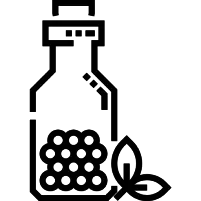
It is estimated that in the space of twenty years, almost 85% of Comoros’ natural forests have disappeared.
As a result, the archipelago ranks a dismal 4th in the world’s fastest-growing deforestation index.
Worse still, between 2000 and 2010, the United Nations estimated an alarming rate of deforestation of over 9% per year.
If this is an ecological disaster in many respects – between drought, landslides and species extinction – there are several causes to blame.
First and foremost, the intensive use of firewood in Comorian homes with little or no electricity supply; although this has been changing for the better in recent years.
Then there is the need to replace the large number of houses built of wood every 3 years.
Last but not least, the ylang industry is said to be the third biggest threat to Comorian forests.
A victim of its own success and energy-hungry needs, the industry is implicated in the ongoing ecological catastrophe in the Comoros.
It alone accounts for 10-15% of total deforestation.
Once again, firewood is to blame.
The country’s many distillers have difficulty obtaining electricity, and many of them distill their ylang using this energy, which destroys the forests.
It is estimated that nearly a ton of wood is needed to obtain 3 liters of essential oil.
When you consider that the country alone produces 70 tonnes of ylang essential oil a year, the math is pretty simple.
Nevertheless, this industry is fundamental to the island’s inhabitants.
More than 10% of the population work in the industry, and this figure is set to rise as global demand increases.
It is therefore urgent to improve and protect it.
Cradled by our ecological preoccupations, we couldn’t get involved in the ylang industry without meeting our environmental requirements.
But it was also out of the question to miss out on this leading perfumery ingredient.
To cure evil, you have to fight it.
So, to minimize our impact, we started from the premise that has always guided us.
For Le Sourceur, a quality essential oil is first and foremost an exceptional fragrance.
And as we’ve already said, this exceptional fragrance is obtained with Ylang extra superior, i.e. the first fraction distilled in 1 hour maximum, and not in 20 hours as its most gourmand fractions require.
The longer we distill, the less wood we use.
So we reduced our impact by a factor of 20.
But that wasn’t enough – touching the forest was out of the question.
So we made a major investment in our company alongside AGK to buy a still that runs entirely on solar energy!
So we’re proud to have in our possession an essential oil that’s ever more solar-powered, 100% pure and natural.
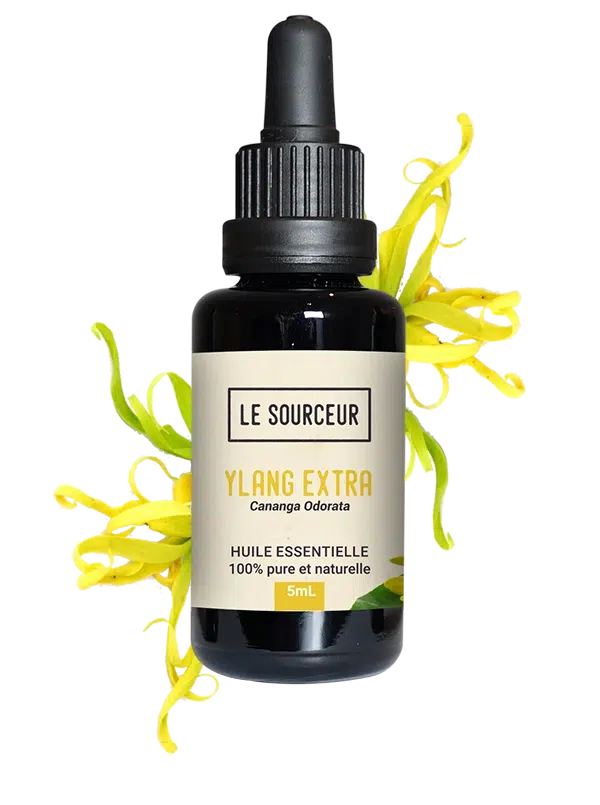
“Ylang-ylang” – Wikipedia
S.Delacourte – “l’hypnotique ylang ylang” – www.sylvaine-delacourte.com
Futura Planète – “ylang ylang qu’est-ce que c’est” – www.futura-sciences.com
Centre tricontinental – Bernard Duterme: “Déforestation: à qui profite le désastre” – www.cetri.be
Initiative Développement – “Appui à la filière ylang-ylang aux comores” – id-ong.org
La Science des Huiles Essentielles médicinales, by Pierre Franchomme, published by Guy Trédaniel, p107-108
Ke-Nako (It’s time), comic strip published by Expression Cosmétique, Drawing by Jef, Story by Stéphane Piquart
Ylang harvesting in the Comoros, best practices, produced by CINEAST | INTERFACE PROD


 informations
informations  mon compte
mon compte  contact
contact Copyright © 2024 Le Sourceur. Tous droits réservés / Développement : Mrlsagency